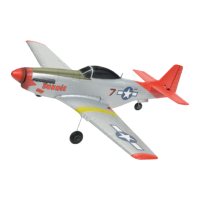
Do you have a question about the EZ-Wings P-51 MUSTANG and is the answer not in the manual?
Read manual thoroughly; model is sophisticated, not a toy, needs careful operation.
Prohibits modifications; disclaims liability for damages from product use.
Covers battery, servo, zone, weather, antenna, and malfunction safety points.
Incorrect handling of Li-Po batteries can lead to fire or injury.
Use specified charger, charge outdoors/ventilated area, monitor temperature.
Store in dry location, temperature controlled, avoid direct sunlight.
Do not disassemble, charge unattended, or overcharge.
Neutralize batteries before recycling; never dispose of with domestic waste.
Disconnect battery, insert charger into USB, connect battery, monitor LED.
Charging takes ~3 hours; avoid charging over 4 hours for safety.
Snap the steel wire of the landing gear onto the slots of the main wing.
Loosen lid, insert 4x LR-6 batteries respecting polarity, close lid.
Turn on transmitter before connecting aircraft battery for automatic recognition.
Open cover, connect battery to ESC, place in case, lock cover.
Battery must be fully charged before each flight for normal operation.
Read all instructions before operation; throttle locks on transmitter power-on.
Overview of one-key functions, gimbals, and trims for flight control.
Switch between Expert, Intermediate, and Beginner flight modes.
Diagram explaining directional control of motor, rudder, aileron, and elevator.
Check servo surface reactions to stick movements on left and right gimbals.
Check how elevator, rudder, and aileron servos react to plane movements.
Three levels (Expert, Intermediate, Beginner) for simplified flying experience.
Enables beginners to perform roll and loop with button press and stick input.
Details on making a claim, required proof of purchase, and shipping defective goods.
Conditions under which the warranty becomes void, such as wear or improper use.
Specifies the claim period for defects from the date of purchase.
Disclaimers on manual accuracy, product changes, and contact for support.
Instructions for proper disposal of batteries and electronic equipment.
Steps for launching the aircraft manually into the wind.
Steps for launching the aircraft from a flat surface into the wind.
Positioning the aircraft nose upwind and in line with the runway for landing.
French instructions for positioning the aircraft and controlling descent.
Dutch instructions for positioning the aircraft and controlling descent.
Link to download the latest version of the manual in multiple languages.
Link to download the latest German version of the manual.
Link to download the latest English version of the manual.